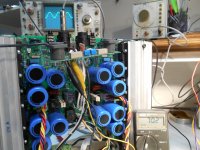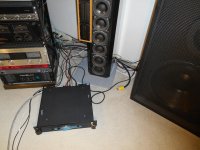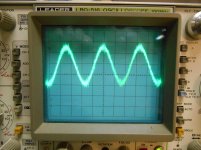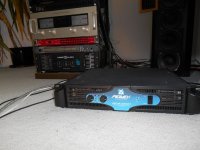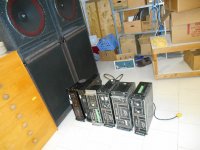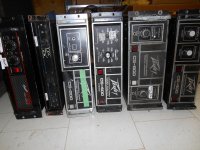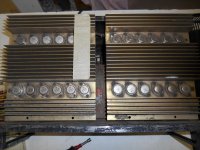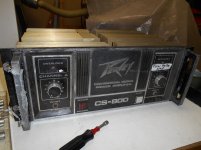Here is the Peavey, back together and temporarily running my RCF sub woofers. The cabinets are copies of JBL cinema sub cabinets. The RCF drivers are 2 db less efficient than the JBL, but were almost 1/4 the cost. Unfortunately, the savings were lost when I was required to replace the Phase Linear 700, driving them, with a Crest CA 18 (occupying the lowest rack space).
So far, I like this Peavey. I had to go to great lengths to get the Crest to behave in a home theatre environment. (I believe my toroid noise thread went on for 38 pages!) The fans also had to be replaced with ultra quite units. The Peavey toroid is silent and the fans apparently don't come on until heat sinks reach 55 degrees Centigrade.
So far, I like this Peavey. I had to go to great lengths to get the Crest to behave in a home theatre environment. (I believe my toroid noise thread went on for 38 pages!) The fans also had to be replaced with ultra quite units. The Peavey toroid is silent and the fans apparently don't come on until heat sinks reach 55 degrees Centigrade.
Attachments
Regarding Cross-over distortion;
Attached is a picture of the amp driven with a small signal, into an 8 Ohm dummy load. The scope was set to 10 mV / division and my Fluke meter called this 10 mV (RMS). I don't see any evidence of cross-over distortion. This is a 1 kHz signal, would 10 kHZ have been a better test signal?
PS; I would like to sincerely thank every at diyaudio and particularly, all who contributed to this thread. I have a tremendous sense of accomplishment but I could not have done it without your help!
Thanks to; thanong , JonSnell Electronic, agdr, Enzo, PRR , AudioFreak88, and of course indianajo, and wg_ski
Merry Christmas, enjoy the holidays all, and Happy New Year, Peter in Canada
Attached is a picture of the amp driven with a small signal, into an 8 Ohm dummy load. The scope was set to 10 mV / division and my Fluke meter called this 10 mV (RMS). I don't see any evidence of cross-over distortion. This is a 1 kHz signal, would 10 kHZ have been a better test signal?
PS; I would like to sincerely thank every at diyaudio and particularly, all who contributed to this thread. I have a tremendous sense of accomplishment but I could not have done it without your help!
Thanks to; thanong , JonSnell Electronic, agdr, Enzo, PRR , AudioFreak88, and of course indianajo, and wg_ski
Merry Christmas, enjoy the holidays all, and Happy New Year, Peter in Canada
Attachments
No vertical lines in your 10 mv signal. I say that is no crossover distortion.
Congratulations. Enjoy the decent sound and silent Peavey fan and transformer.
Congratulations. Enjoy the decent sound and silent Peavey fan and transformer.
Last edited:
...10 mV (RMS). ....
I would bring it up to 1V.
Actually, I would just use it.
congrats on getting it up on it's skates but from the noise on that trace i'd look to see if it's oscillating at high frequency before i'd say it's got it's stick on the ice too...(sorry for the canuck talk der EH!)
or did you max the intensity on the scope for the pic? it may be just low level noise on a 10mv signal...
or did you max the intensity on the scope for the pic? it may be just low level noise on a 10mv signal...
Last edited:
Hi turk;
Thanks for the concern re HF oscillation, the scope was set to 10mV per division. I am a novice but I'm pretty sure this is just the noise floor of the amp. I have struggled with an oscillation problem on one of my Phase Linear's for weeks. (turned out to be an undersized capacitor in the output RC network) I forget the name of that RC string, I seem to remember it sounds like 'Chernobyl', which is kind of fitting for a Phase Linear. When my ear is 6 inches from the 18 inch sub woofer, I can hear this hash.
I am not sure if this is the norm, but my Phase only showed the HF oscillation on the upper lobes of the sine wave. (It only oscillated with a signal present). In the case of this Peavey, the hash was still there on the 'flat line'.
I am going to use this amp in my system until I'm convinced it is working reliably. Next time the wife steps out, I'm going to see if Pink Floyd can get the clip lights to come on! (or at least get the cooling fans to start).
G'day eh! Peter in Canada
Thanks for the concern re HF oscillation, the scope was set to 10mV per division. I am a novice but I'm pretty sure this is just the noise floor of the amp. I have struggled with an oscillation problem on one of my Phase Linear's for weeks. (turned out to be an undersized capacitor in the output RC network) I forget the name of that RC string, I seem to remember it sounds like 'Chernobyl', which is kind of fitting for a Phase Linear. When my ear is 6 inches from the 18 inch sub woofer, I can hear this hash.
I am not sure if this is the norm, but my Phase only showed the HF oscillation on the upper lobes of the sine wave. (It only oscillated with a signal present). In the case of this Peavey, the hash was still there on the 'flat line'.
I am going to use this amp in my system until I'm convinced it is working reliably. Next time the wife steps out, I'm going to see if Pink Floyd can get the clip lights to come on! (or at least get the cooling fans to start).
G'day eh! Peter in Canada
Attachments
with the output being flying rails i hope you where using the differential mode of the scope or an isolation x-former for the device under test.
if that noise is there with no signal it could well be ground loop noise between the scope and the amp.
if that noise is there with no signal it could well be ground loop noise between the scope and the amp.
Last edited:
Hi turk;
I was just using the A Channel on the scope. I used it as a single trace scope (Chan A mode). I only learned about 'flying rail' amps from this thread, when I saw the ground symbol on would have been a conventional amp's output (Hot or Red) terminal.
Have to admit that I cringed when connecting the scope's ground lead to the amp's black terminal. Because the amp has a torroid power transformer with the primary isolated from the amp, can we not disregard all the horror of it's rail configurations and treat it as a normal amp?
The math is a little beyond me but I wonder if this is could be normal (for Peavey) amplifier noise? At worst, this looked like 10 mv P to P. If that is 3.5 mV RMS, how many db is that below the rated output? Peavey specs 89 Volts max swing, although I could only see 70.2 V before clipping, into 8 Ohms. The S/N spec is 115 db.
Thanks again, this continues to be a learning experience, but I looking for the next victim! Peter
I was just using the A Channel on the scope. I used it as a single trace scope (Chan A mode). I only learned about 'flying rail' amps from this thread, when I saw the ground symbol on would have been a conventional amp's output (Hot or Red) terminal.
Have to admit that I cringed when connecting the scope's ground lead to the amp's black terminal. Because the amp has a torroid power transformer with the primary isolated from the amp, can we not disregard all the horror of it's rail configurations and treat it as a normal amp?
The math is a little beyond me but I wonder if this is could be normal (for Peavey) amplifier noise? At worst, this looked like 10 mv P to P. If that is 3.5 mV RMS, how many db is that below the rated output? Peavey specs 89 Volts max swing, although I could only see 70.2 V before clipping, into 8 Ohms. The S/N spec is 115 db.
Thanks again, this continues to be a learning experience, but I looking for the next victim! Peter
sorry i'm just being fussy but for me that much noise on a signal would have me looking real hard to figure out why it's there, but that's just me.
The amps black terminal IS connected to the earth ground. Green wire, 3rd prong on the cord. But the entire power supply on the secondary side is floating and considered hot wrt that ground. Nowhere in the rule book is it stated that some terminal off one of the secondaries needs to be connected directly to earth ground. Some part of the circuit which is considered a zero volt reference (and that users can touch in normal operation) does. Almost always, that's an input ground. It may or may not be a speaker return (a lot of class D amps are full bridge). It may or may not be the negative side of a rail filter cap. In this case it certainly isn't.
MERRY CHRISTMAS ALL!
Thanks for guiding me through the repairs of the GPS 3500. I think this is an idea amp for sub woofer driving, in a larger home theatre system. I still have not been able to get the cooling fans to come on! I suppose I should bench test the amp to verify their operation, but I don't have the nerve to cook this amp, after all the effort I (we) have put into it! The manual claims that the fans won't start until until temps reach 45 degrees C, and normal operating temp is 55 C.
Beyond the satisfaction of repairing this amplifier, you all have helped me get somewhat more comfortable with Class H topology, got introduced to 'flying rails' and learned how to match output transistors.
I have just purchased 6 dead amplifier/door stops and hope I can salvage something useful from the pile!
Thanks again everyone, hope you have some free time over the Holidays,
Peter in Hillsdale, Canada
Thanks for guiding me through the repairs of the GPS 3500. I think this is an idea amp for sub woofer driving, in a larger home theatre system. I still have not been able to get the cooling fans to come on! I suppose I should bench test the amp to verify their operation, but I don't have the nerve to cook this amp, after all the effort I (we) have put into it! The manual claims that the fans won't start until until temps reach 45 degrees C, and normal operating temp is 55 C.
Beyond the satisfaction of repairing this amplifier, you all have helped me get somewhat more comfortable with Class H topology, got introduced to 'flying rails' and learned how to match output transistors.
I have just purchased 6 dead amplifier/door stops and hope I can salvage something useful from the pile!
Thanks again everyone, hope you have some free time over the Holidays,
Peter in Hillsdale, Canada
Attachments
my pick of the litter would be the QSC MX1500 love these amps, the CS800 and CS400 would be next the CS200 is mono (not that that is bad) and last the Traynor Beta 800 these seem to go south in the worst and most critical area the VBe circuit and in many that have come my way the resulting damage to pcb traces makes them a tough repair (take a good look at both sides of the pcb to see if any traces have been repair with wire jumpers that's a sure sign of prior failure and subsequent repair) at a 150 loonies for the lot if you recover one amp your ahead of game and the remainder may serve as project cases and parts. i recycled the input board from a Beta 800 (that was to crispy to rebuild) as the front end of a biamp rig.
Hi Turk;
Thanks for the valuable background info. I would picked the CS800, I have seen them around for some time and thought they could almost be considered 'vintage'. The QSC says 'dual mono' which might have some appeal. Unfortunately this amp is in such rough shape, the rack ears are cracked and I will have to come up with some clever solutions, even if I can get it running.
The Traynor seems to be in the best cosmetic condition, from what you say, it is likely because it has spent so little time functional! I can't wait to peak inside, but I am only allowed so much 'play time'!
Thanks for the valuable background info. I would picked the CS800, I have seen them around for some time and thought they could almost be considered 'vintage'. The QSC says 'dual mono' which might have some appeal. Unfortunately this amp is in such rough shape, the rack ears are cracked and I will have to come up with some clever solutions, even if I can get it running.
The Traynor seems to be in the best cosmetic condition, from what you say, it is likely because it has spent so little time functional! I can't wait to peak inside, but I am only allowed so much 'play time'!
that version of the CS800 is "vintage" production of that style stopped in the early eighties although the CS 800 is still a current model for Peavey(if i'm not mistaken!?) the CS400's are from two different era's.
the quick fix for the rack ears on the MX1500 is 1 1/4" aluminum angle behind the existing rack ear (some milling required)
if the beta 800 lives make sure you never run it into clip on a 4 ohm load that's where things start.
play time and yard time are important for a tech geek otherwise we don't get fresh air or is your play time limited by your significant other?
the quick fix for the rack ears on the MX1500 is 1 1/4" aluminum angle behind the existing rack ear (some milling required)
if the beta 800 lives make sure you never run it into clip on a 4 ohm load that's where things start.
play time and yard time are important for a tech geek otherwise we don't get fresh air or is your play time limited by your significant other?
That original CS800 is a nice workhorse - if you can stand to have a fan running all the time. No convection without it because of the orientation of the heat sinks and the fact that they are totally enclosed. Might be worth adding a variable speed fan with a temp sensor. Back in those days you could run 2x400 watts sine wave off of them indefinitely - don't try that with a modern amp. They did have a high/low fan switch for running normal music, but you do need at least some air even just idling. Rebuild with Mj15024 outputs and drivers, and MJE 340/350 predrivers and VAS and you're golden.
The QSC is the original (not MXa series). Those have a *parallel* as opposed to series class H output stage, and therefore sound better. Very much worth restoring. They are dual mono because they are flying rail.
The QSC is the original (not MXa series). Those have a *parallel* as opposed to series class H output stage, and therefore sound better. Very much worth restoring. They are dual mono because they are flying rail.
Learning already!
Great idea; if I fall in love with the QSC, I could cut off the rack ears and screw-attach some new ones, I think I wound make them steel. I have had a taste of 'flying-rail' and look forward to learning more about Class H.
I want to attack the CS800 first, and could not resist peaking under the hood. I just about to hunt down a schematic, but I can already see the battle scares, never mind matching outputs within a batch--there are at least 4 different types of devices on the heat syncs. I have yet to connect the amp to the variac, but if and when the time comes, I would like to come up with SIMPLE fan control circuit that does not require fabricating a PCB. Maybe as simple as some bi-metal sensor on the heat sinks switching the existing fan or a fancier servo, robbed from something else?
At first glance this amp looks like a BGW 750, but I don't believe those amps had a fan. How about just a perforated top cover? The draw back would be reduced effectiveness of the fan, when required....
Can't wait to get into this amp, but I can't even blame my 'better half' for my time restrictions. Everything around me seems to be falling apart! A dead mini-fridge turned me from a 'Mr. Fix-it' to a "Mr. Replace-it'. While tinkering with a bad compressor start-relay (could have been a $10 fix), I FUBAR'ed the compressor!
It's a sign of the times; I'm repairing something from the 70's and disposing of something made 4 years ago.
Great idea; if I fall in love with the QSC, I could cut off the rack ears and screw-attach some new ones, I think I wound make them steel. I have had a taste of 'flying-rail' and look forward to learning more about Class H.
I want to attack the CS800 first, and could not resist peaking under the hood. I just about to hunt down a schematic, but I can already see the battle scares, never mind matching outputs within a batch--there are at least 4 different types of devices on the heat syncs. I have yet to connect the amp to the variac, but if and when the time comes, I would like to come up with SIMPLE fan control circuit that does not require fabricating a PCB. Maybe as simple as some bi-metal sensor on the heat sinks switching the existing fan or a fancier servo, robbed from something else?
At first glance this amp looks like a BGW 750, but I don't believe those amps had a fan. How about just a perforated top cover? The draw back would be reduced effectiveness of the fan, when required....
Can't wait to get into this amp, but I can't even blame my 'better half' for my time restrictions. Everything around me seems to be falling apart! A dead mini-fridge turned me from a 'Mr. Fix-it' to a "Mr. Replace-it'. While tinkering with a bad compressor start-relay (could have been a $10 fix), I FUBAR'ed the compressor!
It's a sign of the times; I'm repairing something from the 70's and disposing of something made 4 years ago.
Attachments
- Status
- Not open for further replies.
- Home
- Live Sound
- Instruments and Amps
- Pet Peeve Peavey (GPS 3500)
